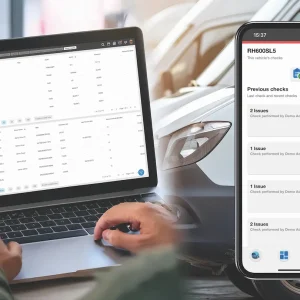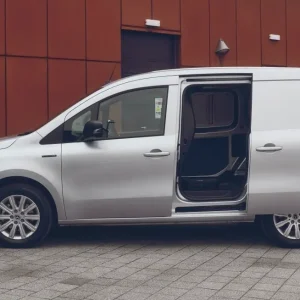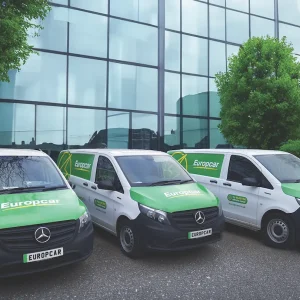 The media has been full of stories of how hydrogen-producing fuel cells are the future of carbon-free automotive transportation, but in reality they are at least 20 years away from cost-effective mainstream implementation.
The media has been full of stories of how hydrogen-producing fuel cells are the future of carbon-free automotive transportation, but in reality they are at least 20 years away from cost-effective mainstream implementation.
In the meantime the focus is on battery-powered vehicles and various electric hybrid systems. All well and good for passenger cars, but vans are a very different proposition. After all, rather than just a few people they have to shift varying degrees of load weights around, and in some cases over long distances. Batteries just can’t hack it.
A British company called Revolve, however, has been quietly beavering away developing a conversion which allows a petrol-powered Ford Transit to run on compressed hydrogen gas.
Revolve started life as the European arm of Roush, the American specialist powertrain, engineering and development company. It went standalone in 2007 and has diversified into product development in many different areas; automotive, defence, hybrid and alternative fuels, marine, and industrial to mention a few. It also happens to be the sole dealer for the current generation Ford GT40.
H2ICE
The starting point for Revolve’s hydrogen (H2) bi-fuel hybrid ICE (Internal Combustion Engine) conversion is a rear-wheel drive 2.3-litre petrol Transit. Minimal alterations are made to the powertrain, really just the addition of a belt-driven supercharger and intercooler, necessary to gain efficiency and control of the very light-weight hydrogen when it’s in the combustion chamber. Think of hydrogen as an energy carrier, rather than a fuel. It combines with oxygen during the combustion and it’s this process that releases energy.
The remainder of the bolt-on conversion is comprised of the hydrogen tanks mounted under the vehicle and the separate induction and electronically-controlled injection systems — the hydrogen delivery system has its own ECU.
The original petrol tank and injection system are retained. It can run on either hydrogen or petrol and the driver can switch between the two.
A petrol engine is used instead of a diesel because the latter requires diesel to be injected as an igniter along with the hydrogen — thanks to compression ignition — which sort of defeats the object of the exercise.
H2 Tanks
 Three carbon fibre-wrapped tanks are used to store 45kg of hydrogen compressed at 350 bar — car tyres are inflated to around two bar to put it in context — and at about £5,000 a go, these account for 67 per cent of the fuel system’s cost. They are supplied by Canadian company Dynatek. It’s infant low volume technology so the cost is high.
Three carbon fibre-wrapped tanks are used to store 45kg of hydrogen compressed at 350 bar — car tyres are inflated to around two bar to put it in context — and at about £5,000 a go, these account for 67 per cent of the fuel system’s cost. They are supplied by Canadian company Dynatek. It’s infant low volume technology so the cost is high.
In the short term customers might be able to lease the tanks to reduce the up-front cost, spreading it over the cylinder’s expected 15 year life-span.
The tanks’ installation — in a steel cage welded to the chassis with a skid plate underneath — meets with Ford’s ground clearance specifications.
Safety
All fuels have to be treated with respect, but it’s mythbusting time. Thanks to the Hindenburg disaster the general perception of hydrogen is that it’s highly combustible and lethal. The real problem on the air ship was the hydrogen peroxide paint (basically solid rocket fuel), not the hydrogen providing the lift.
Hydrogen burns at a significantly lower temperature than petrol and is 22 times weaker than petrol vapour in theoretical explosive power per unit volume of gas. It is also 12 times more diffusive than petrol and accumulates as high as possible rather than low to the ground as a potential ‘fire carpet’ as petrol does.
Nevertheless the tanks have to pass a stringent regime of test, as do all hydrogen tanks. An armour-piercing bullet ruptures the tank, but there’s no explosion, for example.
H2 Production
 As hydrogen doesn’t occur naturally — released in the wild it combines with oxygen to form water — it has to be produced and the easiest and ‘greenest’ way is by using an electrolyser (ITM Power is a specialist in this area) combined with a compressor. Electricity passed through water produces hydrogen and oxygen. Plug it in and hydrogen is produced, stored and can then be quickly transferred to the vehicle tanks.
As hydrogen doesn’t occur naturally — released in the wild it combines with oxygen to form water — it has to be produced and the easiest and ‘greenest’ way is by using an electrolyser (ITM Power is a specialist in this area) combined with a compressor. Electricity passed through water produces hydrogen and oxygen. Plug it in and hydrogen is produced, stored and can then be quickly transferred to the vehicle tanks.
With a conversion efficiency rate of 80 per cent it takes about 10 litres of water to produce enough hydrogen to fill the three tanks.
As with many of the proposed ‘green’ fuel solutions it’s the lack of any re-fuelling infrastructure in the country that is holding up their uptake. To make the most of it, and in this case minimise the use of petrol instead of hydrogen, the operation must be return-to-base to make sense.
On the Road
 Turn the key with the fuel switch set to H2 and the Transit comes to life and it’s a bit of a shock initially. Thanks to the 2.3-litre petrol lump under the bonnet there is very little noise; something we’re not used to. Whenis the last time you drove a petrol-engined van?
Turn the key with the fuel switch set to H2 and the Transit comes to life and it’s a bit of a shock initially. Thanks to the 2.3-litre petrol lump under the bonnet there is very little noise; something we’re not used to. Whenis the last time you drove a petrol-engined van?
The shock continues as we pull away; there’s an almost complete lack of torque. Having re-programmed the brain things settle down, but there is a noticeable lack of power. In fact running on hydrogen drops the power output from 150hp in petrol mode to 90hp. It takes approximately twice as long to reach 60mph.
Progress is sedate and peaceful, and everything is running smoothly. And, of course, there’s very little coming out of the exhaust pipe apart from water vapour and a bit of NOx. Revolve admits that there is a bit more work to do to fine-tune the system with regard to NOx output. It’s very low at high throttle loads, but a bit too high under a quarter throttle. This will be remedied shortly.
Driving the H2ICE Transit means that you can look down on Toyota Prius owners with disdain; and it’s a good feeling.
Revolve reckons in urban usage H2 fuel economy runs at about 31g/km which will provide a range of about 133km (83 miles). Take it out on the motorway and it increases to 25g/km which equates to 193km (120 miles).
Technically, hydrogen-powered vehicles cannot be licensed for UK roads, but this is something that Revolve is working on with the powers that be. The Royal Mail is currently trialling two H2ICE Transits in Stornoway on the Isle of Lewis in the Outer Hebrides.
Verdict
This technology is very much in its infancy so is not cheap at about £45,000, but the fact that it is a bolt-on conversion is a real plus-point. There’s definitely more work to be done, but the price will drop as economies of scale kick-in. A piece of British technology to keep an eye on.





